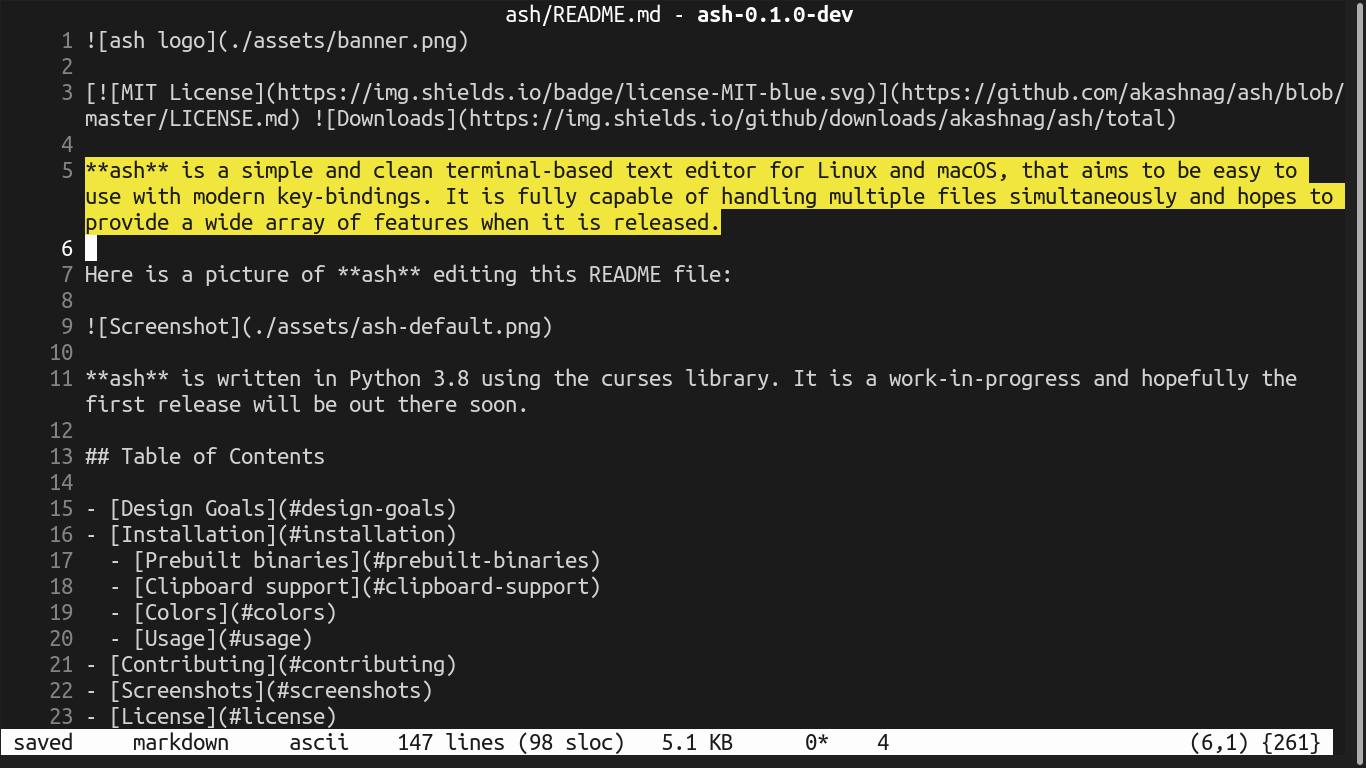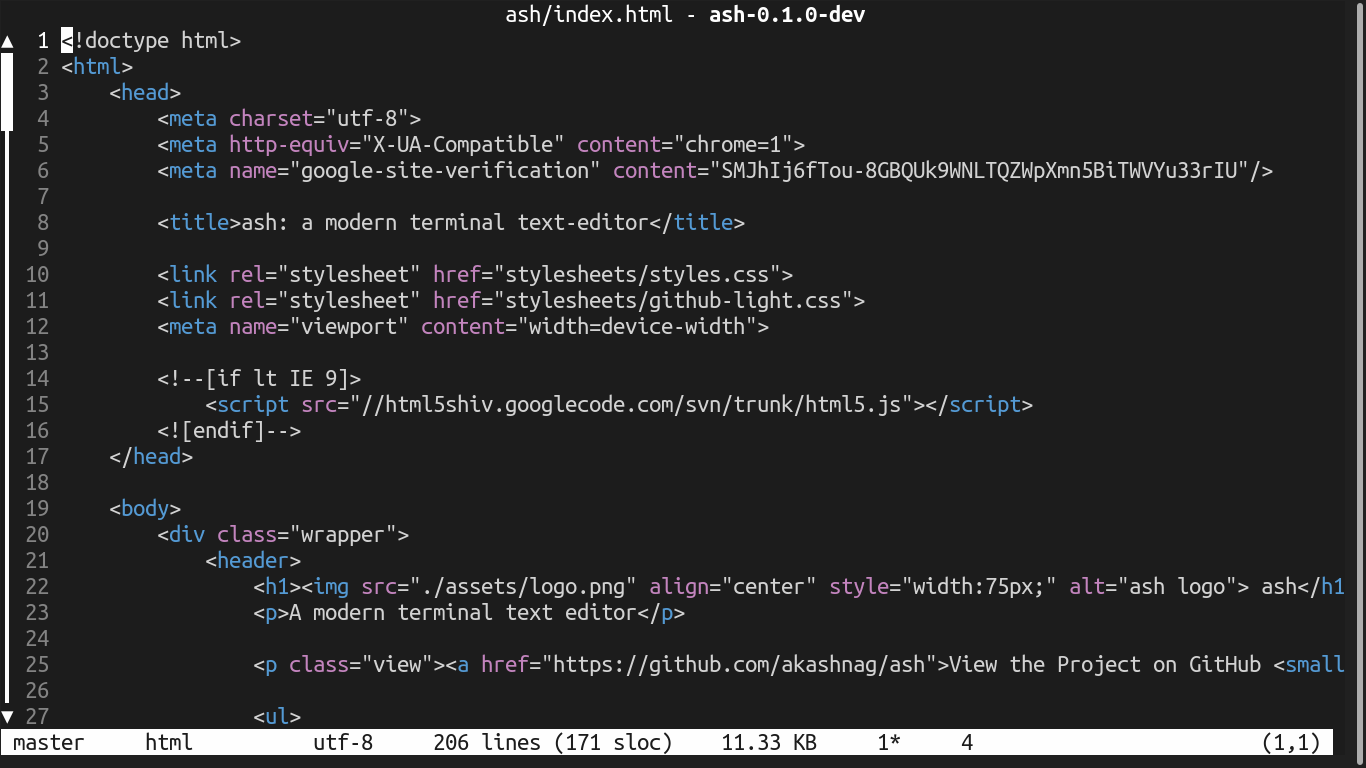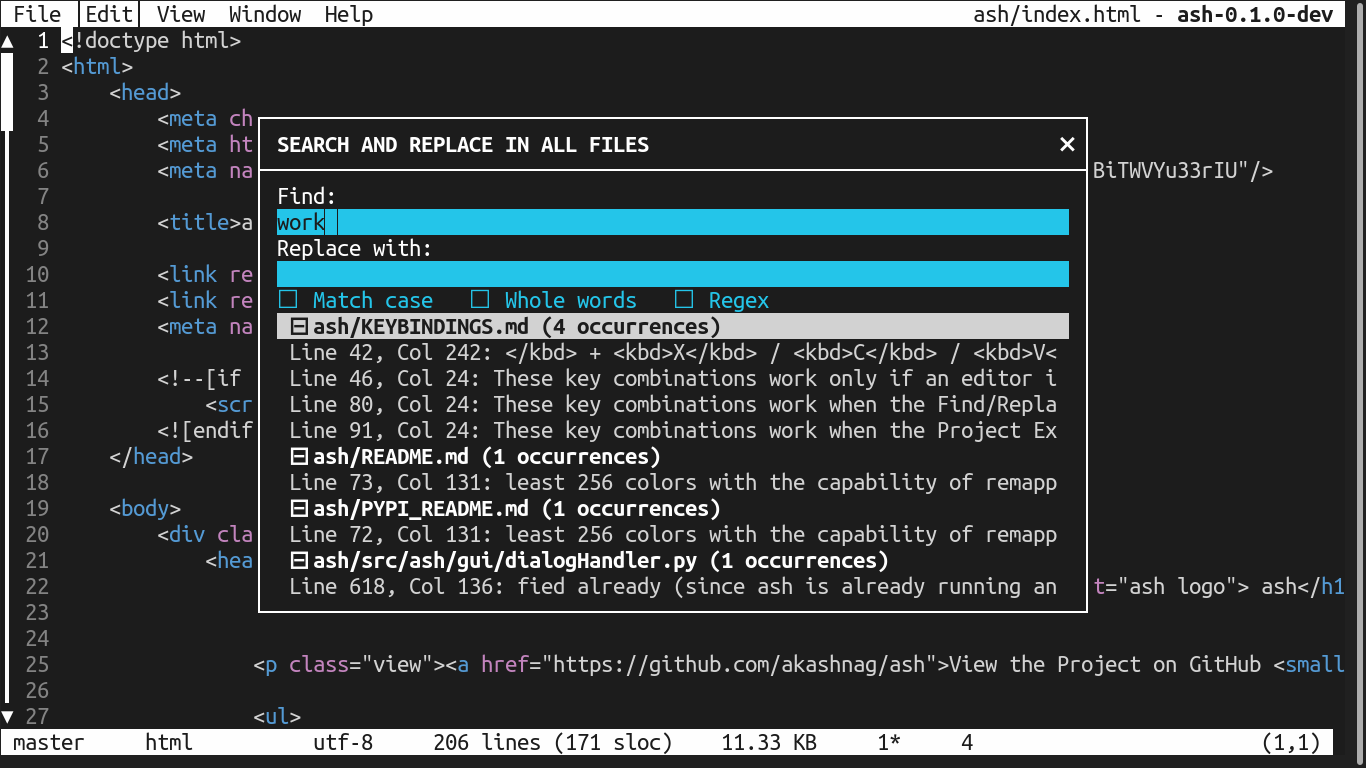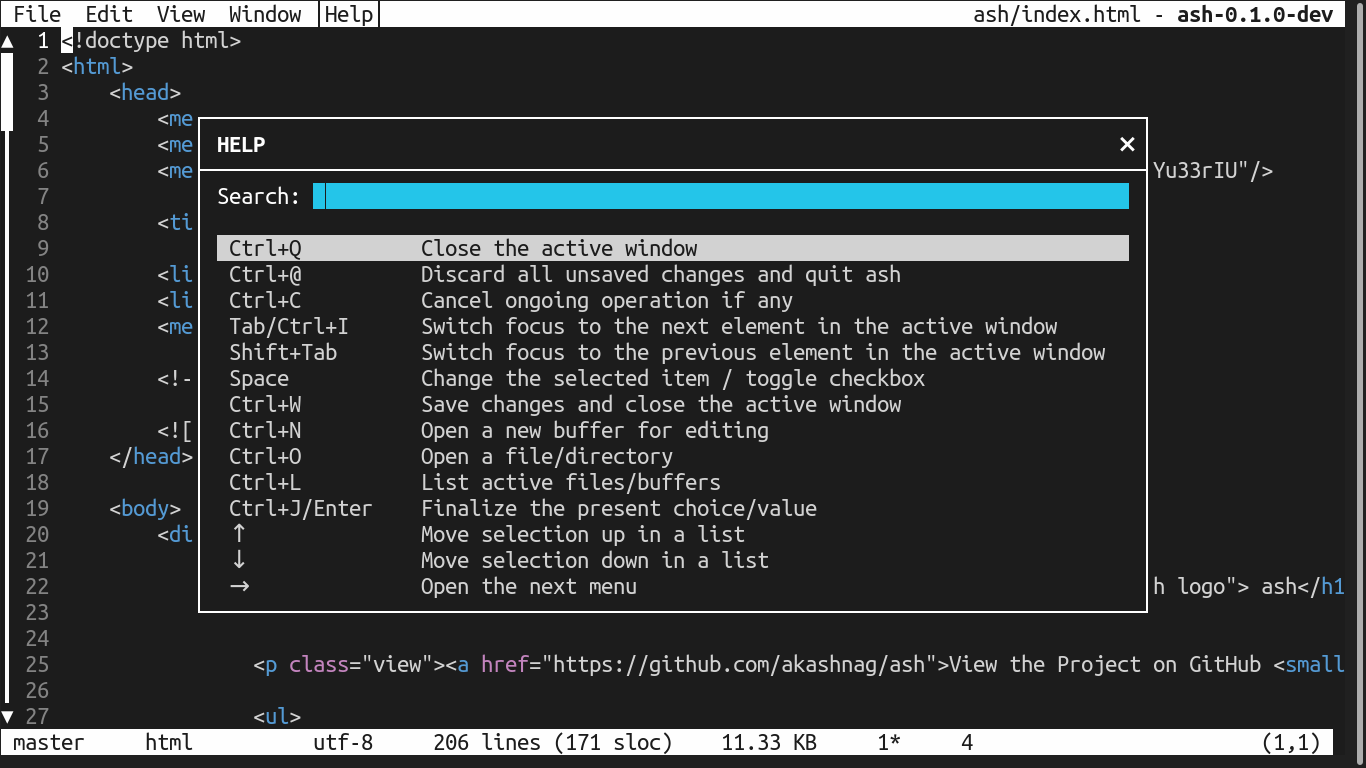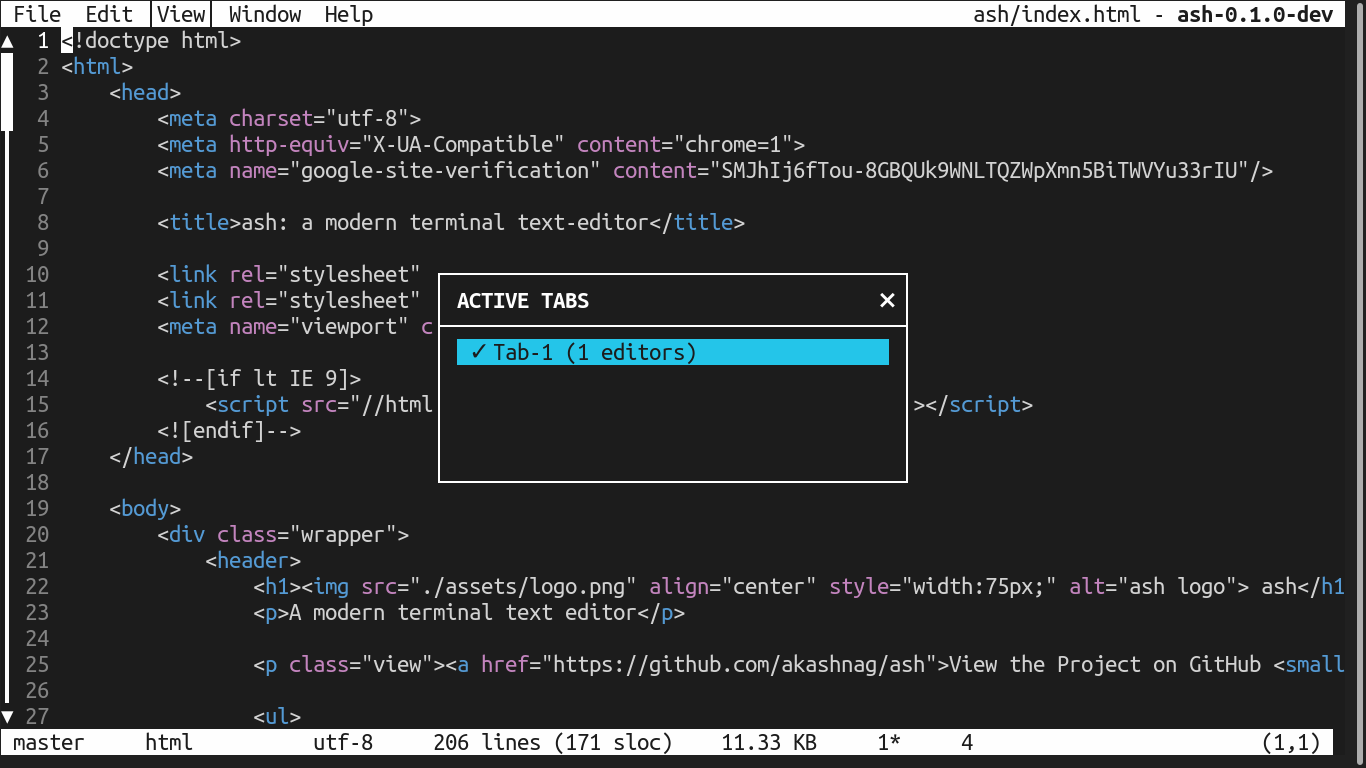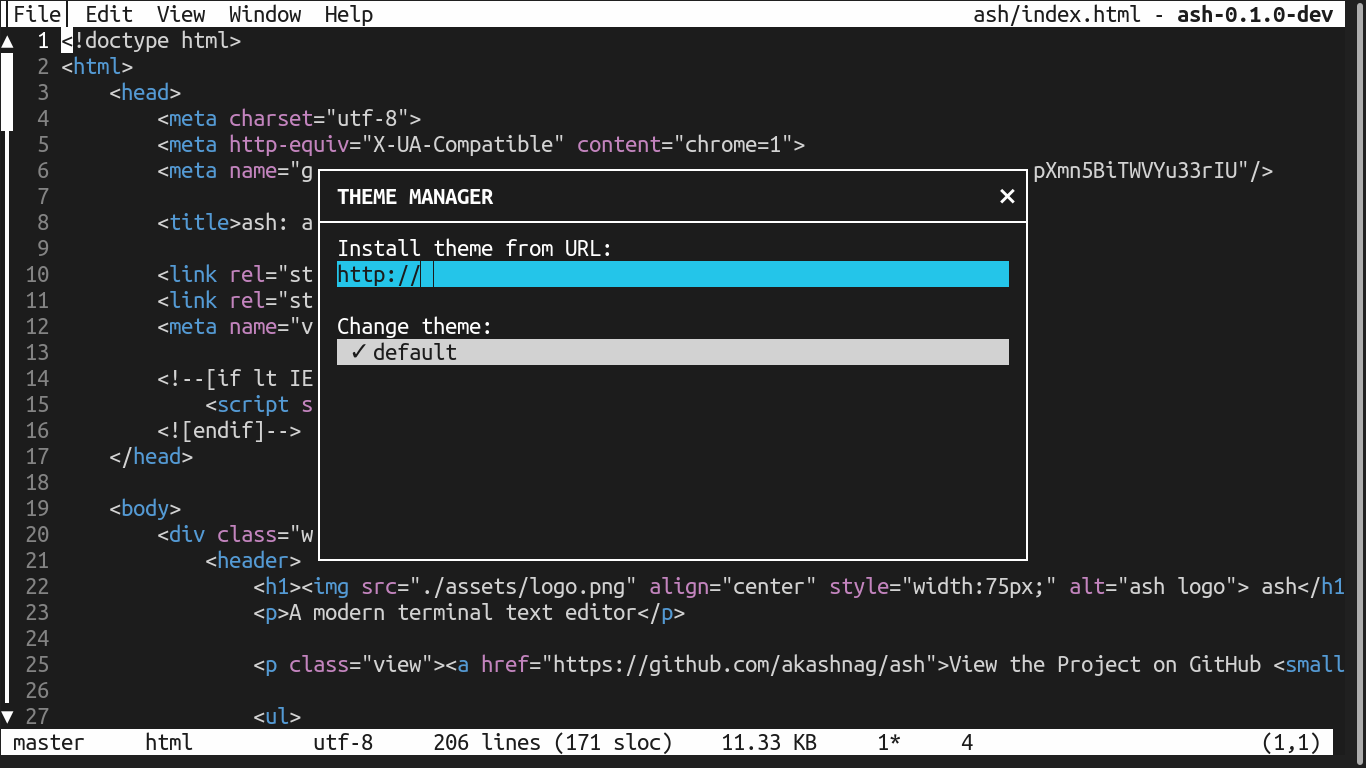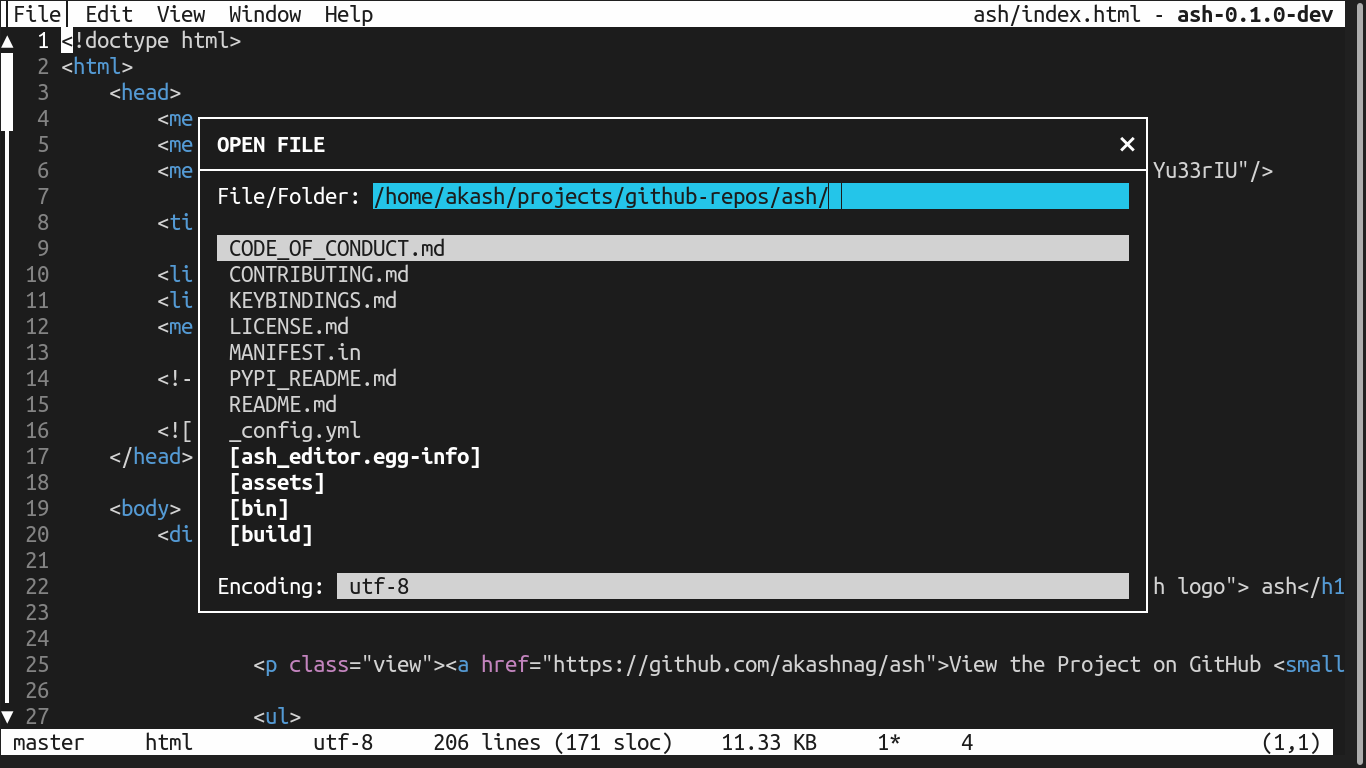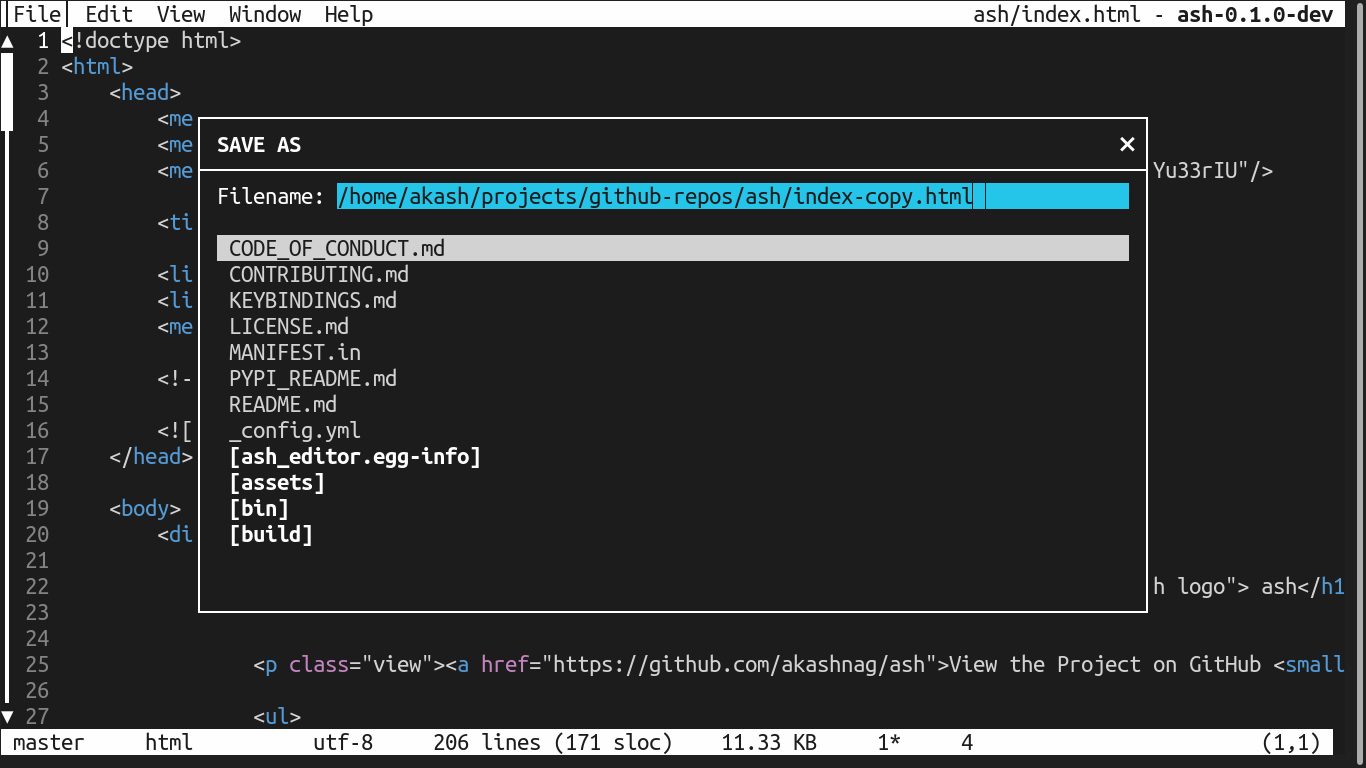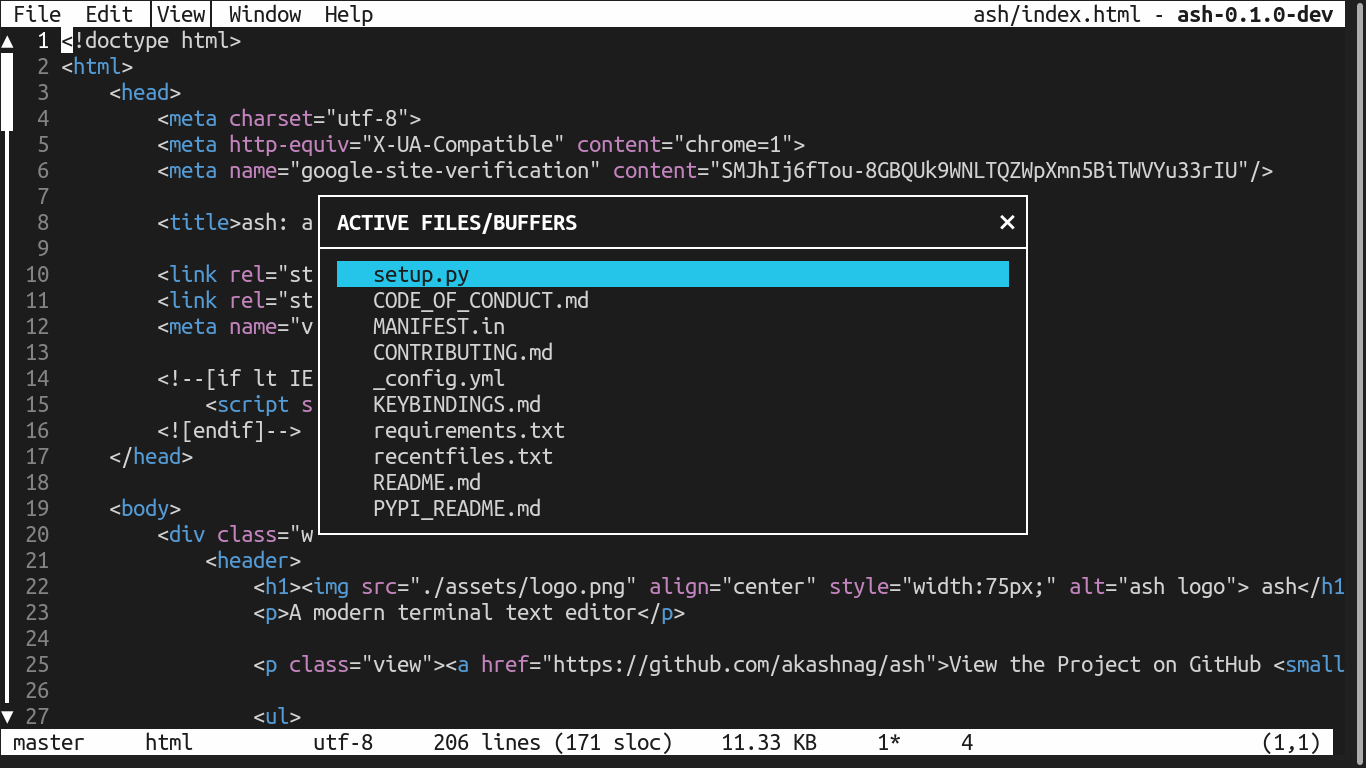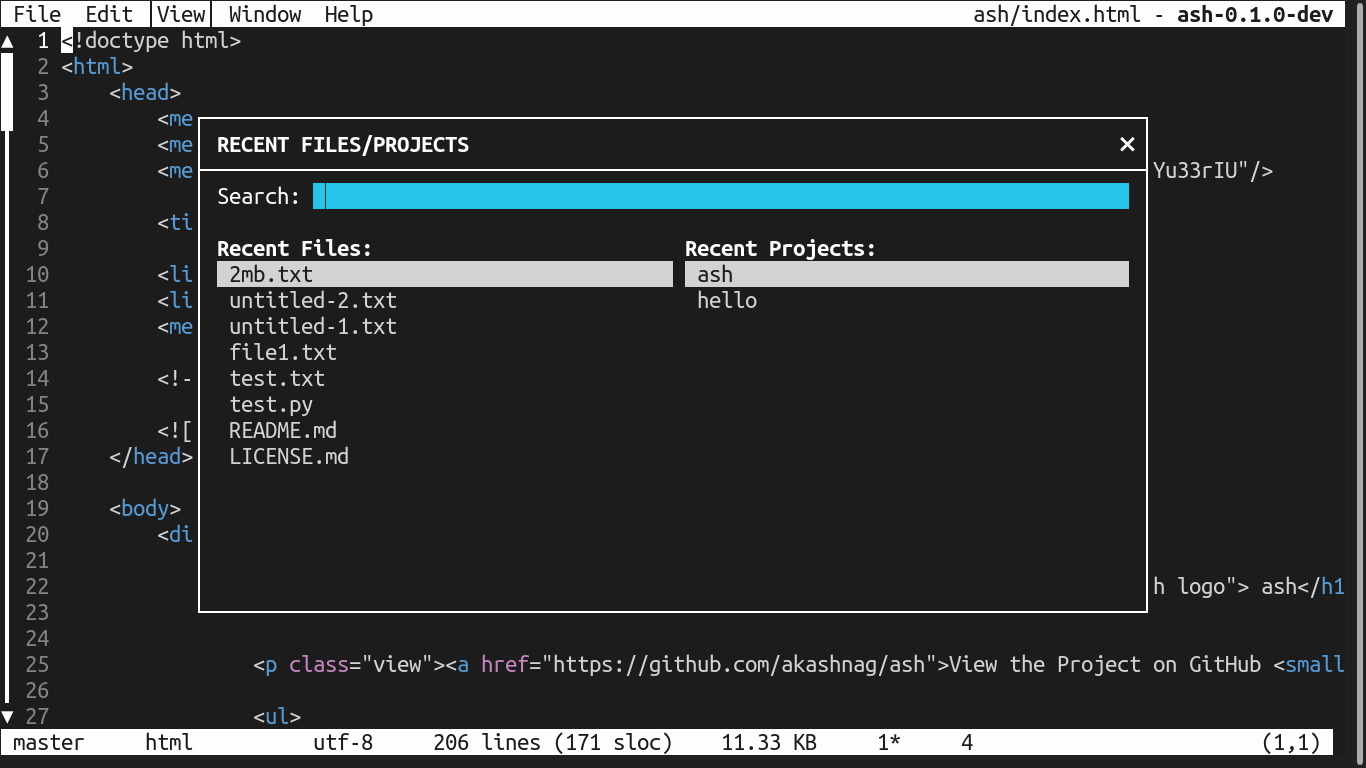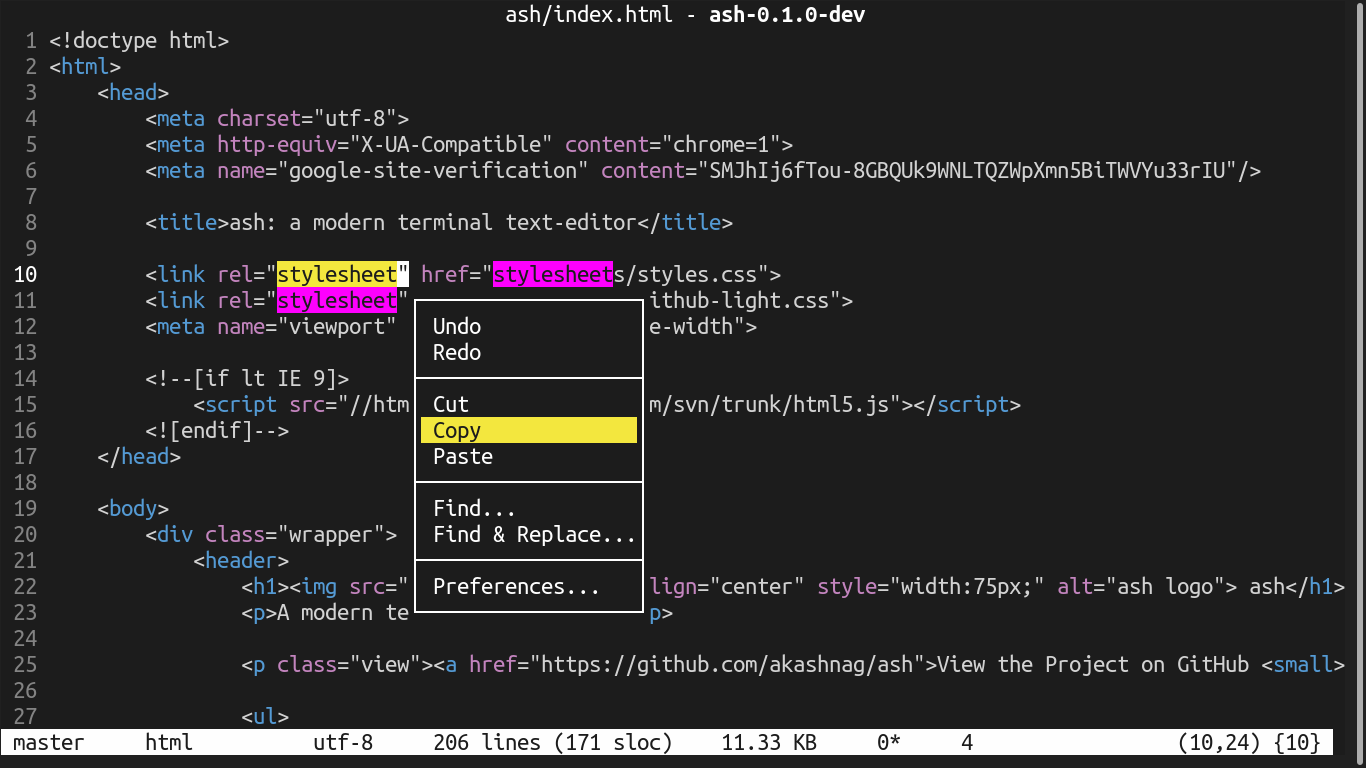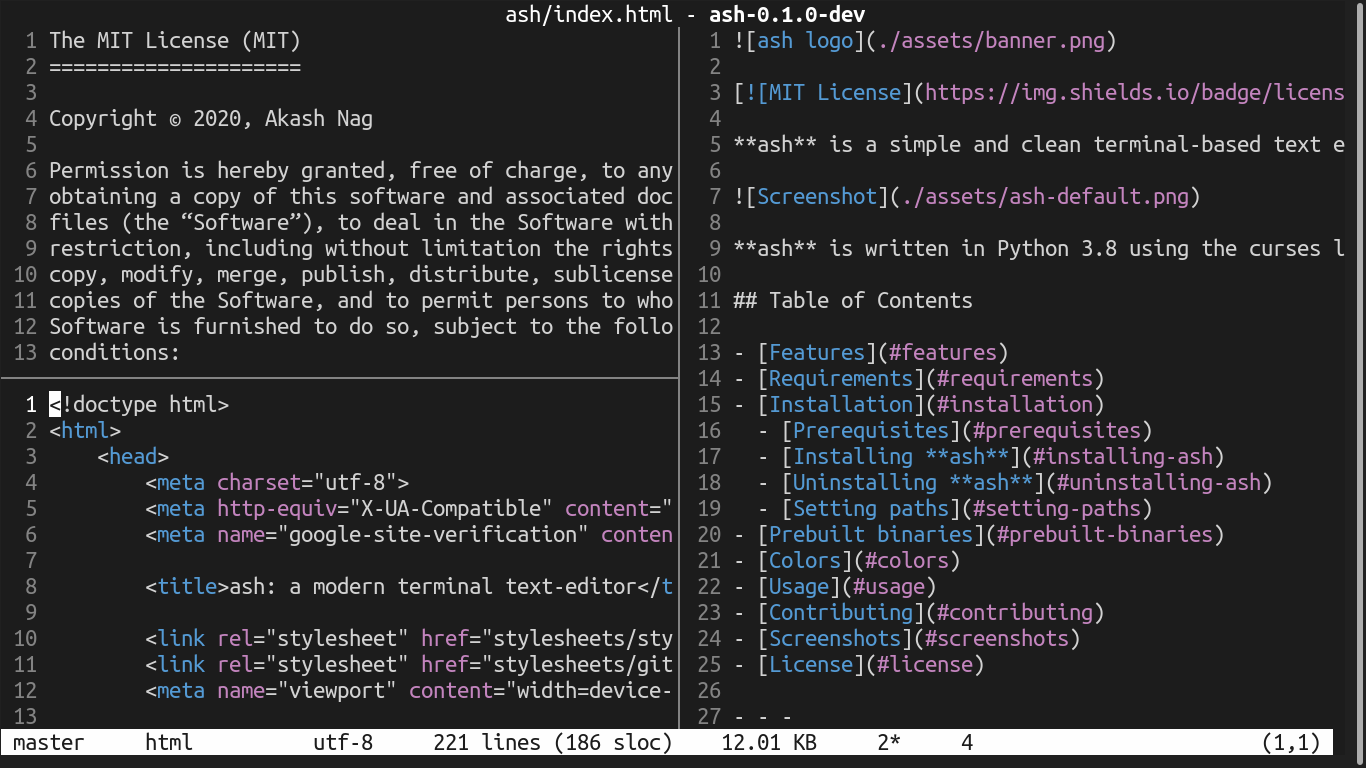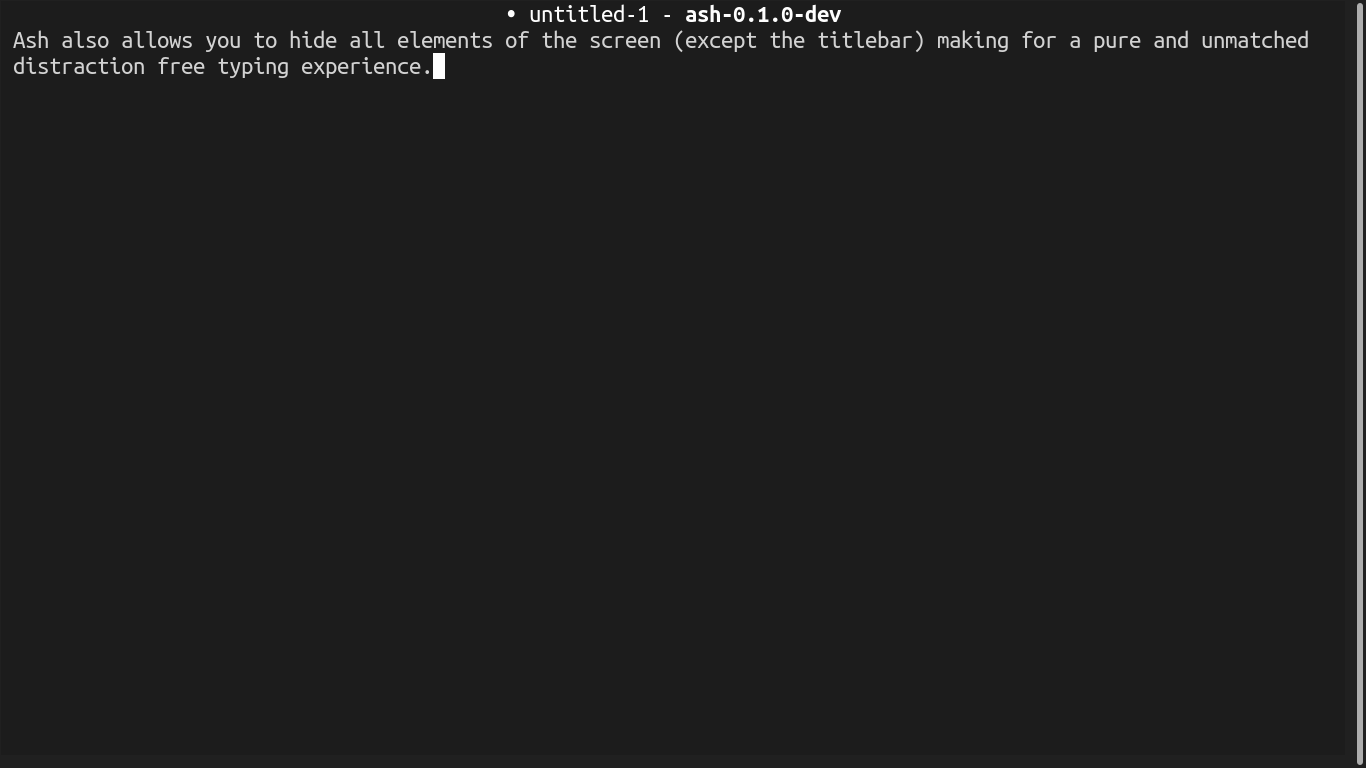ash is a simple and clean terminal-based text editor, that aims to be easy to use with modern key-bindings. It is capable of handling multiple files simultaneously and has a wide array of modern features. Here is a picture of ash editing this README file:
ash is written in Python 3.8 using the curses library.
Note: The latest version is always the nightly build that can be downloaded from the ash website, and the information presented here always refers to that build only. Unless you have any specific reason not to, you should always download the nightly build to get the latest features/updates/bug-fixes.
The following is a list of features available in ash:
- Easy to use, clean and intuitive interface
- Common key bindings (Help on F1, Arrow keys for movement, Shift+Arrow/Home/End/PgUp/PgDown for selecting text, cut/copy/paste using Ctrl+X/C/V, undo/redo using Ctrl+Z/Y, find/replace/goto using Ctrl+F/H/G, etc.)
- Support for remapping key bindings to your taste
- Common editor features such as undo/redo, line numbers, find-replace, cut-copy-paste, etc.
- True support for wrapping (both hard & soft) with intuitive cursor movements along wrapped text
- Auto-backup
- Support for Unicode
- Project mode (opening a directory instead of individual files)
- Complete session (for projects) and undo persistence (turned on for projects opened directly from command-line)
- Live search
- Support for search/replace in all open files
- Support for searching using regular expressions
- Auto-indentation, Select+Tab/Shift-Tab to increase/decrease indent
- Auto insertion of matching braces/quotes and auto-enclosure when text is selected and braces/quotes are typed
- Support for unlimited splits per tab (subject to screen size) and support for unlimited tabs
- Support for various text-encodings
- Checks (live) and reloads (if user permits) files which have been modified externally
- Selection highlighting (highlights text under selection wherever they occur in the document)
- Color scheme customization
- View list of recent files, view project explorer (in project mode)
- Syntax highlighting (limited)
- Git integration (shows untracked, modified files, etc.)
- Multiple Cursors
- Command palette
- Basic mouse support
Roadmap for the future:
The following features will be implemented gradually:
- Plugin system
- Reading from standard input
- Autocompletion/Suggestions
- Macros
- Integrated terminal
- You need a resolution of at least 102 x 22 in your terminal emulator
- Your terminal must support Unicode and be able to display at least 256 colors with the capability of remapping color palettes (Works best on:
xterm-256) - If you are running the source distribution, you need the GNU C compiler collection besides Python 3.8, as some parts of the application are written in Cython. The first time you run the application, Cython will compile and build the
*.pyxfiles, which may increase load time (Ignore the warnings during compilation)
This version of ash has been tested on Ubuntu 20.04 with Python 3.8.2 (64-bit)
You need certain packages and Python 3 itself to download ash, as there are no prebuilt binaries available yet:
$ sudo apt install git
$ sudo apt install xclip
$ sudo apt install python3
$ sudo apt install python3-pipYou have multiple options here:
- Install from PyPi
- Install the latest stable release from GitHub
- Install the latest nightly release from GitHub
- Build and install from source
Execute the following to install from PyPi:
$ sudo pip3 install ash-editorThe above command downloads ash and installs it locally on your system. To be able to invoke ash from anywhere, see the Setting Paths section.
Note: the stable release may not contain all features listed above
Go to the ash Website and download the latest stable release. Then extract the downloaded tar-ball into a folder and once inside that folder, open up your terminal from there and execute:
$ sudo pip3 install .The nightly builds contains all the latest features of ash. Go to the ash Website and download the latest nightly release. Then extract the downloaded tar-ball into a folder and once inside that folder, open up your terminal from there and execute:
$ sudo pip3 install .$ sudo apt install git
$ cd ~
$ git clone --depth 1 -b master https://github.com/akashnag/ash.git
$ cd ash
$ python3 setup.py sdist(Though you can install it directly from here, it is not recommended) You will find the new tar-ball created under dist directory, from where you can proceed as before by first copying the tarball into a new directory, extracting it, and then installing it.
To run ash make sure you have :$HOME/.local/bin appended to your $PATH variable in the file ~/.bashrc. To execute ash, see the Usage section.
To uninstall ash you can use:
$ sudo pip3 uninstall ash-editorSince ash is still under development, prebuilt binaries are not yet available. You can use PyInstaller or similar tools to build one for your system.
If you are using the default Ubuntu terminal, to enable 256 make sure your TERM variable is set to xterm-256color. After ash runs for the first time, it creates a theme.txt file inside your home directory. You can edit that file directly to change how ash looks on your system. The RGB triplets listed in that file range from 0--255. If you want to reset ash to its default colors, delete the configuration file using: rm ~/.ash-editor/theme.txt.
Once you have downloaded the ash source code, and set it up as detailed above, you are ready to use it.
NOTES:
- If you have not updated your path variable, you must specify the full path to the ash binary.
- Your terminal resolution should be at least 102 (width) x 22 (height). Opening the editor in a lower resolution may unexpectedly crash the application. This requirement is necessary to properly display the dialog-boxes.
To run ash:
$ ash path/to/file.txtor, to open an empty buffer:
$ ashor, to open a project (directory):
$ ash path/to/directorySee the Key Bindings for help on how to navigate in ash.
If you find any bugs, please report them. I am also happy to accept pull requests from anyone for either bug-fixes, performance improvements, or for implementing the not-yet-implemented features listed above. Please consider contributing towards new features only when the features listed above have been fully implemented. For more information on what features to implement and the project structure, see the Contribution Guidelines
You can use the GitHub issue tracker to report bugs, ask questions, or suggest new features. You can include the log if that is relevant, which can be found in ~/.ash-editor/log.txt.
For discussions related to the development roadmap and the ash editor in general, you can join the Gitter chat.
Copyright © Akash Nag. All rights reserved.
Licensed under the MIT license.




